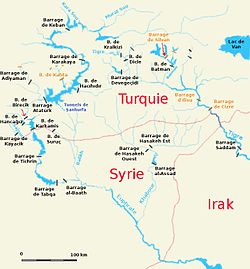Lake Assad
| Lake Assad بحيرة الأسد | ||
|---|---|---|
Primary inflows Euphrates | | |
| Primary outflows | Euphrates | |
| Basin countries | Syria, Turkey | |
| Built | 1968 | |
| First flooded | 1974 | |
| Max. length | 80 km (50 mi) | |
| Max. width | 8 km (5 mi) | |
| Surface area | 525 km2 (203 sq mi) | |
| Water volume | 10 km3 (2.4 cu mi) | |
| Islands | Jazirat al-Thawrah | |
| Settlements | Al-Thawrah | |
Lake Assad (
Project history
The first plans for a dam in the Syrian part of the Euphrates date to 1927, but these were not carried out. In 1957, an agreement was reached with the Soviet Union for technical and financial aid for the construction of a dam in the Euphrates, and in 1960 a financial agreement was signed with West Germany. Another agreement to finance the project was signed with the Soviet Union in 1965.[1] The project included a hydroelectric power station in the Tabqa Dam, and the construction of a vast irrigation network capable of irrigating 640,000 hectares (2,500 sq mi) of land on both sides of the Euphrates.[2][3] Construction of the dam lasted between 1968 and 1973 and the flooding of the reservoir commenced in 1974 by reducing the flow of the Euphrates. The project was completed under the presidency of Hafez al-Assad as part of his modernization policies and agricultural reforms.[4] In 1975, Iraq complained that the flow of the Euphrates had been reduced below an acceptable level and threatened to bomb the Tabqa Dam; mediation by Saudi Arabia and the Soviet Union eventually settled this dispute.[5]
Rescue excavations in the Lake Assad region
In anticipation of the reservoir forming, an intensive, international program of archaeological
Characteristics
The maximum capacity of Lake Assad is 11.7 cubic kilometres (2.8 cu mi) at a surface area of 610 square kilometres (240 sq mi), making it the largest lake in Syria. The actual capacity is, however, much lower at 9.6 cubic kilometres (2.3 cu mi), resulting in a surface area of 447 square kilometres (173 sq mi).[7] The proposed irrigation scheme suffered from a number of problems, including the high gypsum content in the reclaimed soils around Lake Assad, soil salinization, the collapse of canals that distributed the water from Lake Assad, and the unwillingness of farmers to resettle in the reclaimed areas. As a result, only 60,000 hectares (230 sq mi) were irrigated from Lake Assad in 1984.[8] In 2000, the irrigated surface had risen to 124,000 hectares (480 sq mi), which is 19 percent of the projected 640,000 hectares (2,500 sq mi).[9][10] Lake Assad is the most important source of drinking water to Aleppo, providing the city through a pipeline with 80,000,000 cubic metres (2.8×109 cu ft) of drinking water per year.[2] The lake also supports a fishing industry.[11]

The western shore of the lake has developed into an important marshland area. On the southeastern shore, some areas have been reforested with
During the
See also
References
- ISSN 1960-601X
- ^ ISBN 978-0-312-16522-2
- ^ Adeel, Zafar; Mainguet, Monique (2000), Summary Report of the Workshop, New Approaches to Water Management in Central Asia, United Nations University/ICARDA, pp. 208–22
- ISBN 978-0-313-26213-5.
- ISSN 1092-5481
- JSTOR 3768538
- ISSN 0022-1694
- OCLC 44250830
- ]
- ISSN 1492-8442
- ^ Krouma, I. (2006), "National Aquaculture Sector Overview. Syrian Arab Republic. National Aquaculture Sector Overview Fact Sheets", FAO Fisheries and Aquaculture Department, FAO, retrieved 15 December 2009
- OCLC 150245788
- ^ "ISIS And Assad Waging A 'Water War,' Draining Key Lake That May Make A Bad Situation Even Worse". International Business Times. 2014-07-07. Retrieved 2017-10-09.
